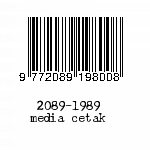Kepuasan dan Loyalitas Konsumen pada Lembaga Kursus Bahasa Inggris: Perspektif Experiential Marketing
Abstract
The research examines the impact of experiential marketing on customer satisfaction and loyalty towards the services provided by MEC Palu, as well as the impact of this satisfaction on consumer loyalty. This research used a descriptive associative approach, and involved 155 MEC Palu members as a sample selected through a stratified random sampling technique. The sample was divided into three different groups. For data analysis, the structural equation modeling (SEM) method was used. The findings show that experiential marketing has a positive and significant influence on both consumer satisfaction and consumer loyalty. Furthermore, there is evidence that shows consumer satisfaction has a positive and significant impact on customer loyalty. This shows that the implementation of experiential marketing strategies is very important to increase customer satisfaction and loyalty at MEC Palu as an effective marketing strategy to maintain and increase customer loyalty through satisfying experiences.
References
Bell, E., Bryman, A., & Harley, B. (2022). Business research methods. Oxford University Press.
Brakus, J. J., Schmitt, B. H., & Zhang, S. (2014). Experiential product attributes and preferences for new products: The role of processing fluency. Journal of Business Research, 67(11), 2291–2298. https://doi.org/10.1016/j.jbusres.2014.06.017.
Copland, F., Garton, S., & Burns, A. (2014). Challenges in teaching English to young learners: Global perspectives and local realities. Tesol Quarterly, 48(4), 738-762. https://doi.org/10.1002/tesq.148.
Dewaele, J. M., Chen, X., Padilla, A. M., & Lake, J. (2019). The flowering of positive psychology in foreign language teaching and acquisition research. Frontiers in Psychology, 10(9), 1-13. https://doi.org/10.3389/fpsyg.2019.02128.
Dörnyei, Z., & Ushioda, E. (2021). Teaching and researching motivation. Routledge.
Elfil, M., & Negida, A. (2017). Sampling methods in clinical research; An educational review. Emergency, 5(1). 52-55. https://www.ncbi.nlm.nih.gov/pmc/articles/PMC5325924/.
Etikan, I., & Bala, K. (2017). Sampling and sampling methods. Biometrics & Biostatistics International Journal, 5(6), 215-217. https://doi.org/10.15406/bbij.2017.05.00149.
Golonka, E. M., Bowles, A. R., Frank, V. M., Richardson, D. L., & Freynik, S. (2014). Technologies for foreign language learning: A review of technology types and their effectiveness. Computer Assisted Language Learning, 27(1), 70–105. https://doi.org/10.1080/09588221.2012.700315.
Hair, J. F., Risher, J. J., Sarstedt, M., & Ringle, C. M. (2019). When to use and how to report the results of PLS-SEM. European Business Review, 31(1), 2–24. https://doi.org/10.1108/EBR-11-2018-0203.
Hoyle, R. H. (2012). Handbook of structural equation modeling. Guilford Press.
Khan, I., Fatma, M., Shamim, A., Joshi, Y., & Rahman, Z. (2020). Gender, loyalty card membership, age, and critical incident recovery: Do they moderate experience-loyalty relationship? International Journal of Hospitality Management, 89, 102408. https://doi.org/10.1016/j.ijhm.2019.102408.
Kline, R. B. (2023). Principles and practice of structural equation modeling. Guilford Publications.
Kranzbühler, A., Kleijnen, M. H. P., Morgan, R. E., & Teerling, M. (2018). The multilevel nature of customer experience research: An integrative review and research agenda. International Journal of Management Reviews, 20(2), 433–456. https://doi.org/10.1111/ijmr.12140.
Lemon, K. N., & Verhoef, P. C. (2016). Understanding customer experience throughout the customer journey. Journal of Marketing, 80(6), 69–96. https://doi.org/10.1509/jm.15.0420.
Levitt, H. M., Bamberg, M., Creswell, J. W., Frost, D. M., Josselson, R., & Suárez-Orozco, C. (2018). Journal article reporting standards for qualitative primary, qualitative meta-analytic, and mixed methods research in psychology: The APA Publications and Communications Board task force report. American Psychologist, 73(1), 26-46. https://doi.org/10.1037/amp0000151.
Mardiatmi, A. B. D., & Pinem, D. (2020). Literasi promotional mix pada UKM-UKM di kota Depok, Jawa Barat. Yumary: Jurnal Pengabdian Kepada Masyarakat, 1(2), 89–98. https://doi.org/10.35912/jpm.v1i2.89
Mercer, S., & Dörnyei, Z. (2020). Engaging language learners in contemporary classrooms. Cambridge University Press.
Ningsih, A., & Sari, R. N. (2024). Customer value dan customer experience terhadap customer satisfaction. JEMSI (Jurnal Ekonomi, Manajemen, Dan Akuntansi), 10(3), 2171–2178. https://doi.org/10.35870/jemsi.v10i3.2610.
Ong, C. H., Lee, H. W., & Ramayah, T. (2018). Impact of brand experience on loyalty. Journal of Hospitality Marketing and Management, 27(7), 755–774. https://doi.org/10.1080/19368623.2018.1445055.
Pinner, R. (2019). Authenticity and teacher-student motivational synergy: A narrative of language teaching. Routledge.
Pratama, H. F. (2016). Pengaruh kualitas pelayanan petugas terhadap kepuasan pengunjung di objek wisata sejarah Benteng Marlborough di Kota Bengkulu. EKOMBIS REVIEW: Jurnal Ilmiah Ekonomi Dan Bisnis, 4(1). 24-35. https://doi.org/10.37676/ekombis.v4i1.152.
Prentice, C., & Loureiro, S. M. C. (2017). An asymmetrical approach to understanding configurations of customer loyalty in the airline industry. Journal of Retailing and Consumer Services, 38, 96–107. https://doi.org/10.1016/j.jretconser.2017.05.005.
Prentice, C., Wang, X., & Loureiro, S. M. C. (2019). The influence of brand experience and service quality on customer engagement. Journal of Retailing and Consumer Services, 50, 50–59. https://doi.org/10.1016/j.jretconser.2019.04.020.
Rahmat, D., & Rofi, A. (2022). UMKM berbasis digital marketing di Desa Perbawati Sukabumi. Surya: Jurnal Pengabdian Kepada Masyarakat, 4(2), 55–62. https://doi.org/10.37150/jsu.v4i2.1750.
Rahmat, R., & Marso, M. (2020). Hubungan brand experience, brand image, brand satisfaction, dan brand loyalty dalam pespektif four-stage loyalty model (Studi terhadap mahasiswa pengguna smartphone di Tarakan). Jurnal Manajemen Pemasaran, 14(1), 17–24. https://doi.org/10.9744/pemasaran.14.1.17-24.
Rather, R. A. (2020). Customer experience and engagement in tourism destinations: The experiential marketing perspective. Journal of Travel & Tourism Marketing, 37(1), 15–32. https://doi.org/10.1080/10548408.2019.1686101.
Rather, R. A., & Hollebeek, L. D. (2019). Exploring and validating social identification and social exchange-based drivers of hospitality customer loyalty. International Journal of Contemporary Hospitality Management, 31(3), 1432–1451. https://doi.org/10.1108/IJCHM-10-2017-0627.
Rather, R. A., & Sharma, J. (2017). Customer engagement for evaluating customer relationships in hotel industry. European Journal of Tourism, Hospitality and Recreation, 8(1), 1–13. https://doi.org/10.1515/ejthr-2017-0001.
Richards, J. C. (2015). The changing face of language learning: Learning beyond the classroom. Relc Journal, 46(1), 5–22. https://doi.org/10.1177/003368821456162.
Schmitt, B. (2011). Experience marketing: Concepts, frameworks and consumer insights. Foundations and Trends® in Marketing, 5(2), 55–112. http://dx.doi.org/10.1561/1700000027.
Schmitt, B., & Zarantonello, L. (2013). Consumer experience and experiential marketing: A critical review. Review of Marketing Research, 10, 25–61. https://doi.org/10.1108/S1548-6435(2013)0000010006.
Schumacker, E., & Lomax, G. (2016). A Beginner’s Guide to Structural Equation Modelling (4th ed). Routledge.
Sekaran, U., & Bougie, R. (2016). Research methods for business: A skill building approach. John Wiley & Sons.
Sharma, G. (2017). Pros and cons of different sampling techniques. International Journal of Applied Research, 3(7), 749–752. https://doi.org/10.4236/me.2022.139061.
Sharma, S., Mukherjee, S., Kumar, A., & Dillon, W. R. (2005). A simulation study to investigate the use of cutoff values for assessing model fit in covariance structure models. Journal of Business Research, 58(7), 935–943. https://doi.org/10.1016/j.jbusres.2003.10.007.
Taherdoost, H. (2016). Sampling methods in research methodology; How to choose a sampling technique for research. International Journal of Academic Research in Management (IJARM), 5(2). 18-27. http://dx.doi.org/10.2139/ssrn.3205035.
Tarka, P. (2018). An overview of structural equation modeling: Its beginnings, historical development, usefulness and controversies in the social sciences. Quality & Quantity, 52, 313–354. https://doi.org/10.1007/s11135-017-0469-8.
Wiedmann, K.-P., Labenz, F., Haase, J., & Hennigs, N. (2018). The power of experiential marketing: exploring the causal relationships among multisensory marketing, brand experience, customer perceived value and brand strength. Journal of Brand Management, 25, 101–118. https://doi.org/10.1057/s41262-017-0061-5.
Yin, R. K. (2018). Case study research and applications. Sage.
Copyright (c) 2024 Hesti Evrianti, Asriadi, Adfiyani Fadjar

This work is licensed under a Creative Commons Attribution-ShareAlike 4.0 International License.

















